seat memory MERCEDES-BENZ G-Class 2015 W463 Owner's Manual
[x] Cancel search | Manufacturer: MERCEDES-BENZ, Model Year: 2015, Model line: G-Class, Model: MERCEDES-BENZ G-Class 2015 W463Pages: 350, PDF Size: 6.44 MB
Page 11 of 350
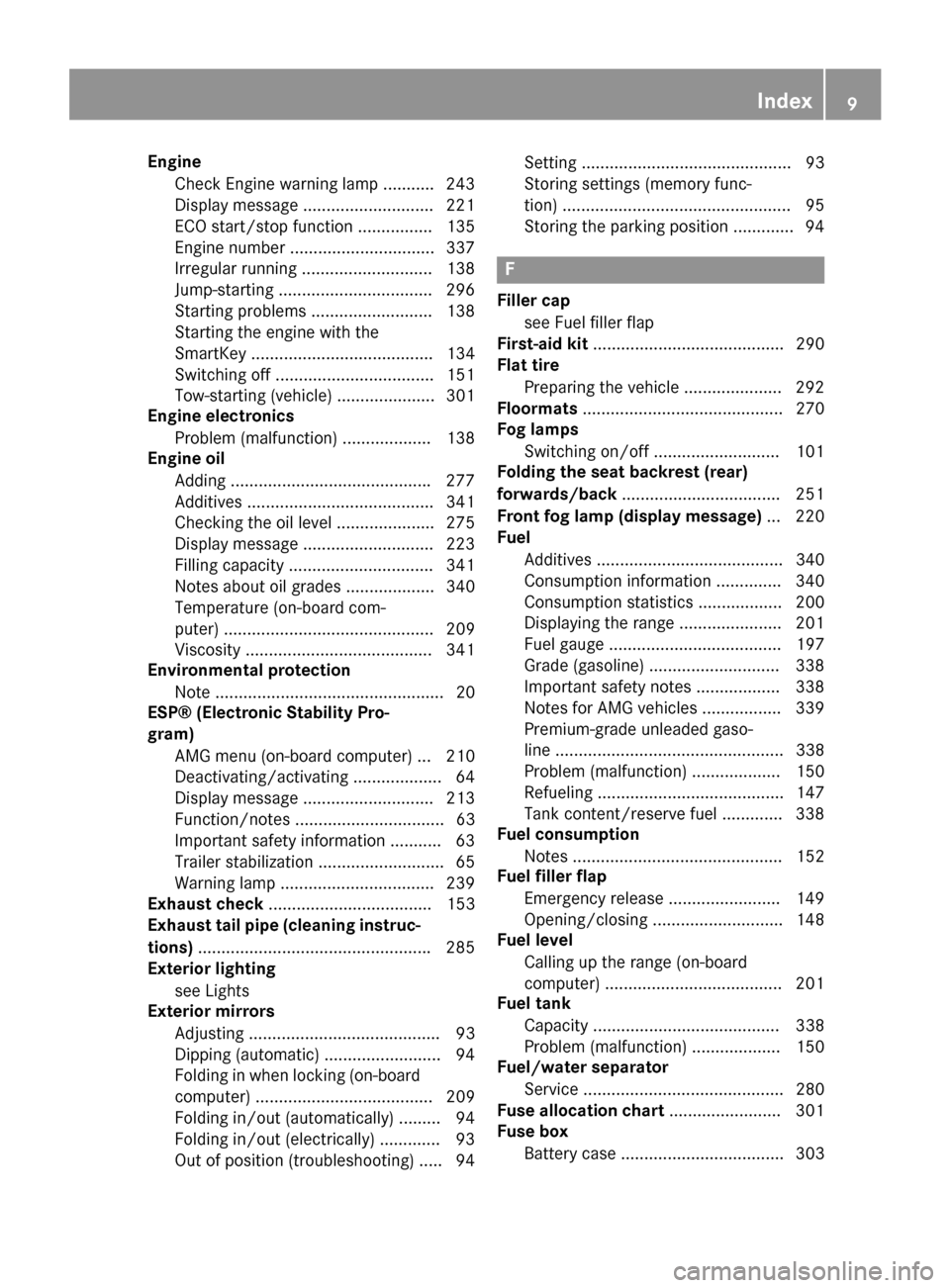
Engine
Check Engine warning lamp .......... .243
Display message ............................ 221
ECO start/stop function ................ 135
Engine number ............................... 337
Irregular running ............................ 138
Jump-starting ................................. 296
Starting problems .......................... 138
Starting the engine with the
SmartKey ....................................... 134
Switching off .................................. 151
Tow-starting (vehicle) ..................... 301
Engine electronics
Problem (malfunction) ................... 138
Engine oil
Adding .......................................... .277
Additives ........................................ 341
Checking the oil level ..................... 275
Display message ............................ 223
Filling capacity ............................... 341
Notes about oil grades ................... 340
Temperature (on-board com-
puter) ............................................. 209
Viscosity ........................................ 341
Environmental protection
Note ................................................. 20
ESP® (Electronic Stability Pro-
gram)
AMG menu (on-board computer) ... 210
Deactivating/activating ................... 64
Display message ............................ 213
Function/notes ................................ 63
Important safety information ........... 63
Trailer stabilization ........................... 65
Warning lamp ................................. 239
Exhaust check ................................... 153
Exhaust tail pipe (cleaning instruc-
tions) ................................................. .285
Exterior lighting
see Lights
Exterior mirrors
Adjusting ......................................... 93
Dipping (automatic) ......................... 94
Folding in when locking (on-board
computer) ...................................... 209
Folding in/out (automatically) ......... 94
Folding in/out (electrically) ............. 93
Out of position (troubleshooting) ..... 94 Setting ............................................. 93
Storing settings (memory func-
tion) ................................................. 95
Storing the parking position ............. 94 F
Filler cap see Fuel filler flap
First-aid kit ......................................... 290
Flat tire
Preparing the vehicle ..................... 292
Floormats ........................................... 270
Fog lamps
Switching on/of f........................... 101
Folding the seat backrest (rear)
forwards/back .................................. 251
Front fog lamp (display message) ... 220
Fuel
Additives ........................................ 340
Consumption information .............. 340
Consumption statistics .................. 200
Displaying the range ...................... 201
Fuel gaug e..................................... 197
Grade (gasoline )............................ 338
Important safety notes .................. 338
Notes for AMG vehicles ................. 339
Premium-grade unleaded gaso-
line ................................................. 338
Problem (malfunction) ................... 150
Refueling ........................................ 147
Tank content/reserve fue l............. 338
Fuel consumption
Notes ............................................. 152
Fuel filler flap
Emergency release ........................ 149
Opening/closing ............................ 148
Fuel level
Calling up the range (on-board
computer) ...................................... 201
Fuel tank
Capacity ........................................ 338
Problem (malfunction) ................... 150
Fuel/water separator
Service ........................................... 280
Fuse allocation chart ........................ 301
Fuse box
Battery case ................................... 303 Index
9
Page 16 of 350
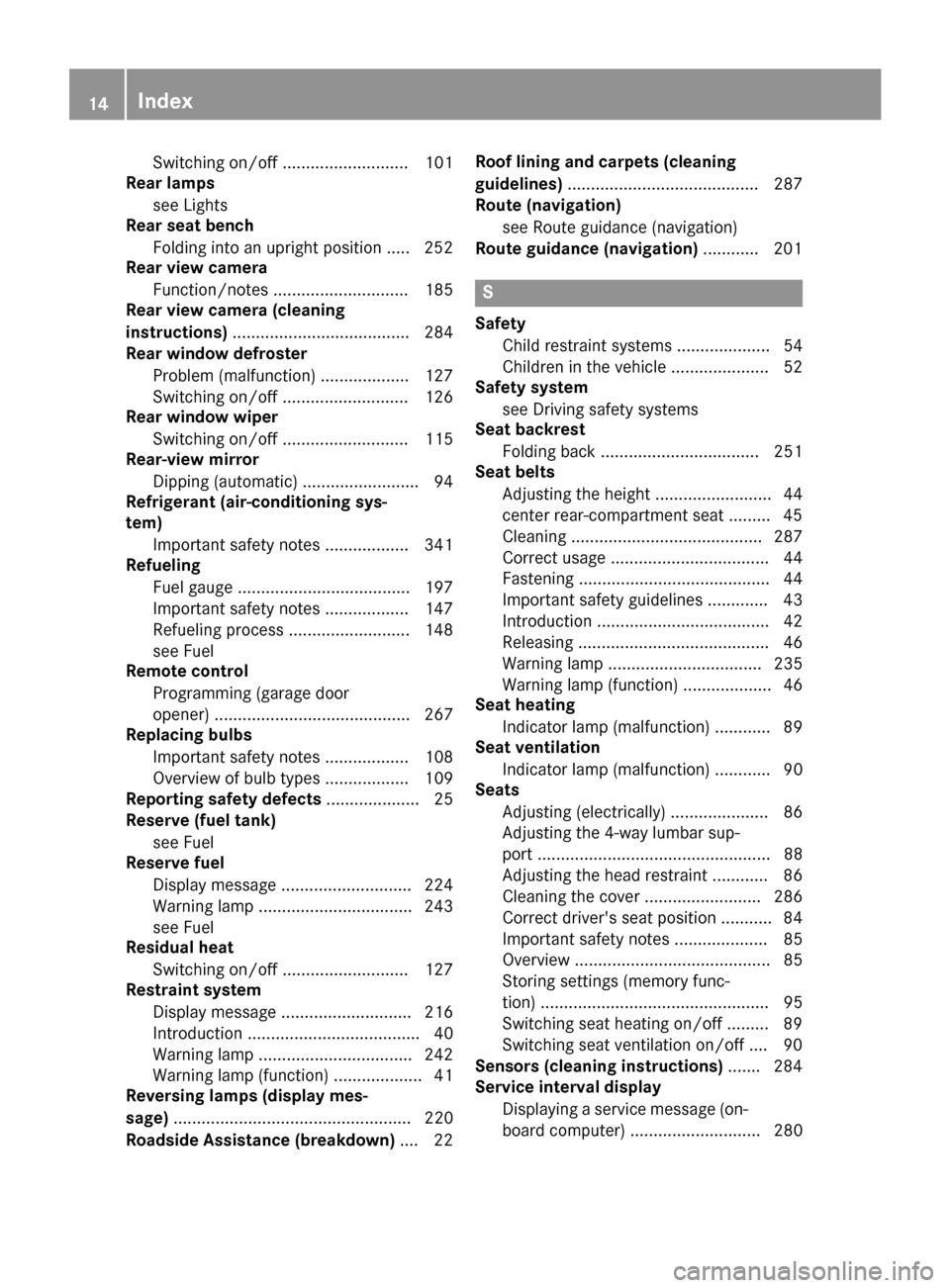
Switching on/of
f........................... 101
Rear lamps
see Lights
Rear seat bench
Folding into an upright position ..... 252
Rear view camera
Function/note s............................. 185
Rear view camera (cleaning
instructions) ...................................... 284
Rear window defroster
Problem (malfunction) ................... 127
Switching on/of f........................... 126
Rear window wiper
Switching on/of f........................... 115
Rear-view mirror
Dipping (automatic) ......................... 94
Refrigerant (air-conditioning sys-
tem)
Important safety notes .................. 341
Refueling
Fuel gaug e..................................... 197
Important safety notes .................. 147
Refueling process .......................... 148
see Fuel
Remote control
Programming (garage door
opener) .......................................... 267
Replacing bulbs
Important safety notes .................. 108
Overview of bulb types .................. 109
Reporting safety defects .................... 25
Reserve (fuel tank)
see Fuel
Reserve fuel
Display message ............................ 224
Warning lamp ................................. 243
see Fuel
Residual heat
Switching on/of f........................... 127
Restraint system
Display message ............................ 216
Introduction ..................................... 40
Warning lamp ................................. 242
Warning lamp (function) ................... 41
Reversing lamps (display mes-
sage) ................................................... 220
Roadside Assistance (breakdown) .... 22Roof lining and carpets (cleaning
guidelines)
......................................... 287
Route (navigation)
see Route guidance (navigation)
Route guidance (navigation) ............ 201 S
Safety Child restraint systems .................... 54
Children in the vehicle ..................... 52
Safety system
see Driving safety systems
Seat backrest
Folding back .................................. 251
Seat belts
Adjusting the height ......................... 44
center rear-compartment sea t......... 45
Cleaning ......................................... 287
Correct usage .................................. 44
Fastening ......................................... 44
Important safety guidelines ............. 43
Introduction ..................................... 42
Releasing ......................................... 46
Warning lamp ................................. 235
Warning lamp (function) ................... 46
Seat heating
Indicator lamp (malfunction) ............ 89
Seat ventilation
Indicator lamp (malfunction) ............ 90
Seats
Adjusting (electrically) ..................... 86
Adjusting the 4-way lumbar sup-
port .................................................. 88
Adjusting the head restraint ............ 86
Cleaning the cover ......................... 286
Correct driver's seat position ........... 84
Important safety notes .................... 85
Overview .......................................... 85
Storing settings (memory func-
tion) ................................................. 95
Switching seat heating on/of f......... 89
Switching seat ventilation on/of f.... 90
Sensors (cleaning instructions) ....... 284
Service interval display
Displaying a service message (on-board computer) ............................ 280 14
Index
Page 17 of 350
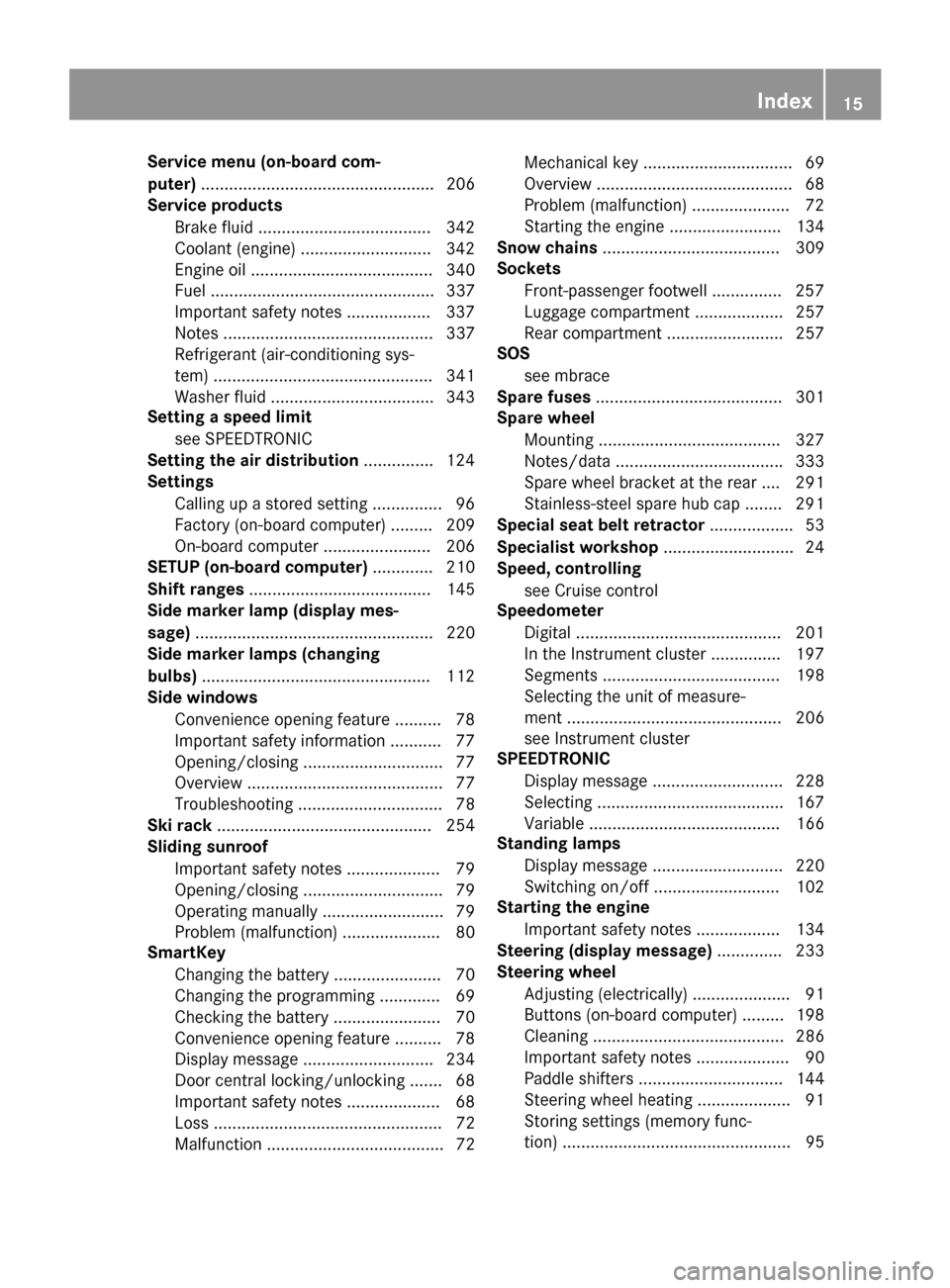
Service menu (on-board com-
puter)
.................................................. 206
Service products
Brake fluid .....................................3 42
Coolant (engine) ............................ 342
Engine oil ....................................... 340
Fuel ................................................ 337
Important safety notes .................. 337
Notes ............................................. 337
Refrigerant (air-conditioning sys-
tem) ............................................... 341
Washer fluid ................................... 343
Setting a speed limit
see SPEEDTRONIC
Setting the air distribution ...............124
Settings
Calling up a stored setting .............. .96
Factory (on-board computer) ......... 209
On-board computer ....................... 206
SETUP (on-board computer) ............. 210
Shift ranges ....................................... 145
Side marker lamp (display mes-
sage) ................................................... 220
Side marker lamps (changing
bulbs) ................................................ .112
Side windows
Convenience opening feature .......... 78
Important safety information ........... 77
Opening/closing .............................. 77
Overview .......................................... 77
Troubleshooting ............................... 78
Ski rack .............................................. 254
Sliding sunroof
Important safety notes .................... 79
Opening/closing .............................. 79
Operating manually .......................... 79
Problem (malfunction) ..................... 80
SmartKey
Changing the battery ....................... 70
Changing the programming ............. 69
Checking the battery ....................... 70
Convenience opening feature .......... 78
Display message ............................ 234
Door central locking/unlocking ....... 68
Important safety notes .................... 68
Loss ................................................. 72
Malfunction ...................................... 72 Mechanical key ................................ 69
Overview .......................................... 68
Problem (malfunction) ..................... 72
Starting the engine ........................ 134
Snow chains ...................................... 309
Sockets
Front-passenger footwell .............. .257
Luggage compartment ................... 257
Rear compartment ......................... 257
SOS
see mbrace
Spare fuses ........................................ 301
Spare wheel
Mounting ....................................... 327
Notes/data ................................... .333
Spare wheel bracket at the rear .... 291
Stainless-steel spare hub cap ....... .291
Special seat belt retractor .................. 53
Specialist workshop ............................ 24
Speed, controlling
see Cruise control
Speedometer
Digital ............................................ 201
In the Instrument cluster .............. .197
Segments ...................................... 198
Selecting the unit of measure-
ment .............................................. 206
see Instrument cluster
SPEEDTRONIC
Display message ............................ 228
Selecting ........................................ 167
Variabl e......................................... 166
Standing lamps
Display message ............................ 220
Switching on/of f........................... 102
Starting the engine
Important safety notes .................. 134
Steering (display message) .............. 233
Steering wheel
Adjusting (electrically) ..................... 91
Buttons (on-board computer) ......... 198
Cleaning ......................................... 286
Important safety notes .................... 90
Paddle shifters ............................... 144
Steering wheel heating .................... 91
Storing settings (memory func-
tion) ................................................. 95 Index
15
Page 39 of 350
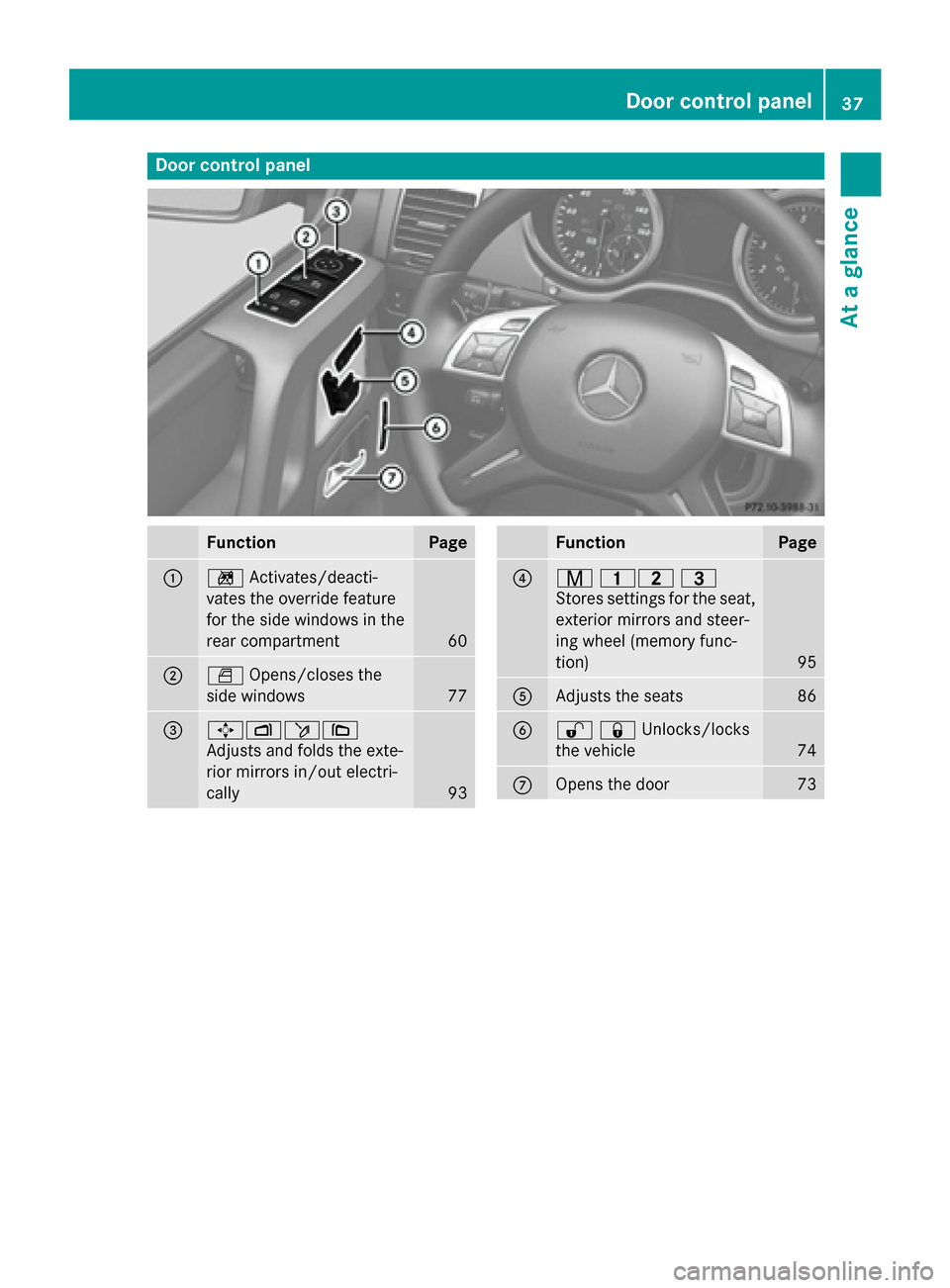
Door control panel
Function Page
:
n
Activates/deacti-
vates the override feature
for the side windows in the
rear compartment 60
;
W
Opens/closes the
side windows 77
=
7Zö
\
Adjusts and folds the exte-
rior mirrors in/out electri-
cally 93 Function Page
?
r
45 =
Stores settings for the seat, exterior mirrors and steer-
ing wheel (memory func-
tion) 95
A
Adjusts the seats 86
B
%&Unlocks/locks
the vehicle
74
C
Opens the door 73Door control panel
37At a glance
Page 62 of 350

G
WARNING
When leaving the vehicle, always remove the
SmartKey from the ignition lock. Always take
the SmartKey with you and lock the vehicle.
Do not leave children unattended in the vehi- cle, even if they are secured in a child restraint
system, or with access to an unlocked vehicle. A child's unsupervised access to a vehicle
could result in an accident and/or serious
personal injury. The children could:
R injure themselves on parts of the vehicle
R be seriously or fatally injured through
excessive exposure to extreme heat or cold
R injure themselves or cause an accident with
vehicle equipment that can be operated
even if the SmartKey is removed from the
ignition lock or removed from the vehicle,
such as seat adjustment, steering wheel
adjustment, or the memory function
If children open a door, they could injure other
persons or get out of the vehicle and injure
themselves or be injured by following traffic.
Do not expose the child restraint system to
direct sunlight. The child restraint system's
metal parts, for example, could become very
hot, and the child could be burned on these
parts.
Child-proof locks for the rear doors G
WARNING
Children could open a rear door from inside
the vehicle. This could result in serious inju-
ries or an accident. Therefore, when children
ride in the rear always secure the rear doors
with the child-proof locks.
You secure each door individually with the
child-proof locks on the rear doors. A door
secured with a child-proof lock cannot be
opened from inside the vehicle. When the
vehicle is unlocked, the door can be opened
from the outside. X
To activate: press the child-proof lock
lever down in the direction of arrow ;.
X Make sure that the child-proof locks are
working properly.
X To deactivate: press the child-proof lock
lever up in the direction of arrow :.
Override feature for the rear side win-
dows G
WARNING
When children ride on the vehicle's rear seats, activate the override switch. Otherwise, the
children could be injured, e.g. by trapping
themselves in the rear side window. X
To activate/deactivate: press button:.
If indicator lamp ;is lit, operation of the
rear side windows is disabled. Operation is
only possible using the switches in the driv- er's door. If indicator lamp ;is off, oper-
ation is possible using the switches in the
rear compartment. 60
Children in the vehicleSafety
Page 75 of 350
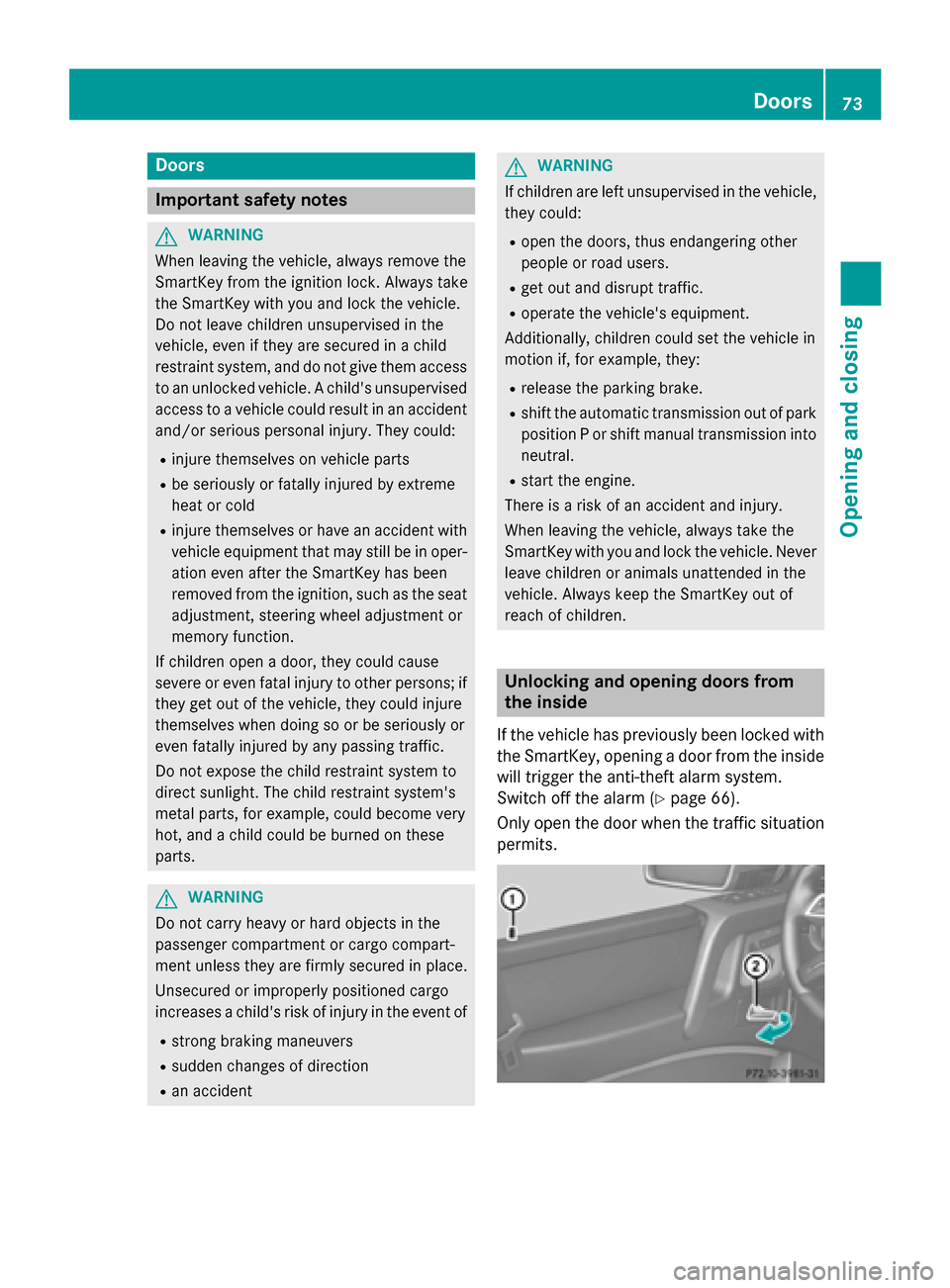
Doors
Important safety notes
G
WARNING
When leaving the vehicle, always remove the
SmartKey from the ignition lock. Always take
the SmartKey with you and lock the vehicle.
Do not leave children unsupervised in the
vehicle, even if they are secured in a child
restraint system, and do not give them access to an unlocked vehicle. A child's unsupervised
access to a vehicle could result in an accident
and/or serious personal injury. They could:
R injure themselves on vehicle parts
R be seriously or fatally injured by extreme
heat or cold
R injure themselves or have an accident with
vehicle equipment that may still be in oper-
ation even after the SmartKey has been
removed from the ignition, such as the seat
adjustment, steering wheel adjustment or
memory function.
If children open a door, they could cause
severe or even fatal injury to other persons; if they get out of the vehicle, they could injure
themselves when doing so or be seriously or
even fatally injured by any passing traffic.
Do not expose the child restraint system to
direct sunlight. The child restraint system's
metal parts, for example, could become very
hot, and a child could be burned on these
parts. G
WARNING
Do not carry heavy or hard objects in the
passenger compartment or cargo compart-
ment unless they are firmly secured in place.
Unsecured or improperly positioned cargo
increases a child's risk of injury in the event of
R strong braking maneuvers
R sudden changes of direction
R an accident G
WARNING
If children are left unsupervised in the vehicle, they could:
R open the doors, thus endangering other
people or road users.
R get out and disrupt traffic.
R operate the vehicle's equipment.
Additionally, children could set the vehicle in
motion if, for example, they:
R release the parking brake.
R shift the automatic transmission out of park
position P or shift manual transmission into
neutral.
R start the engine.
There is a risk of an accident and injury.
When leaving the vehicle, always take the
SmartKey with you and lock the vehicle. Never leave children or animals unattended in the
vehicle. Always keep the SmartKey out of
reach of children. Unlocking and opening doors from
the inside
If the vehicle has previously been locked with the SmartKey, opening a door from the inside
will trigger the anti-theft alarm system.
Switch off the alarm (Y page 66).
Only open the door when the traffic situation
permits. Doors
73Opening and closing Z
Page 78 of 350
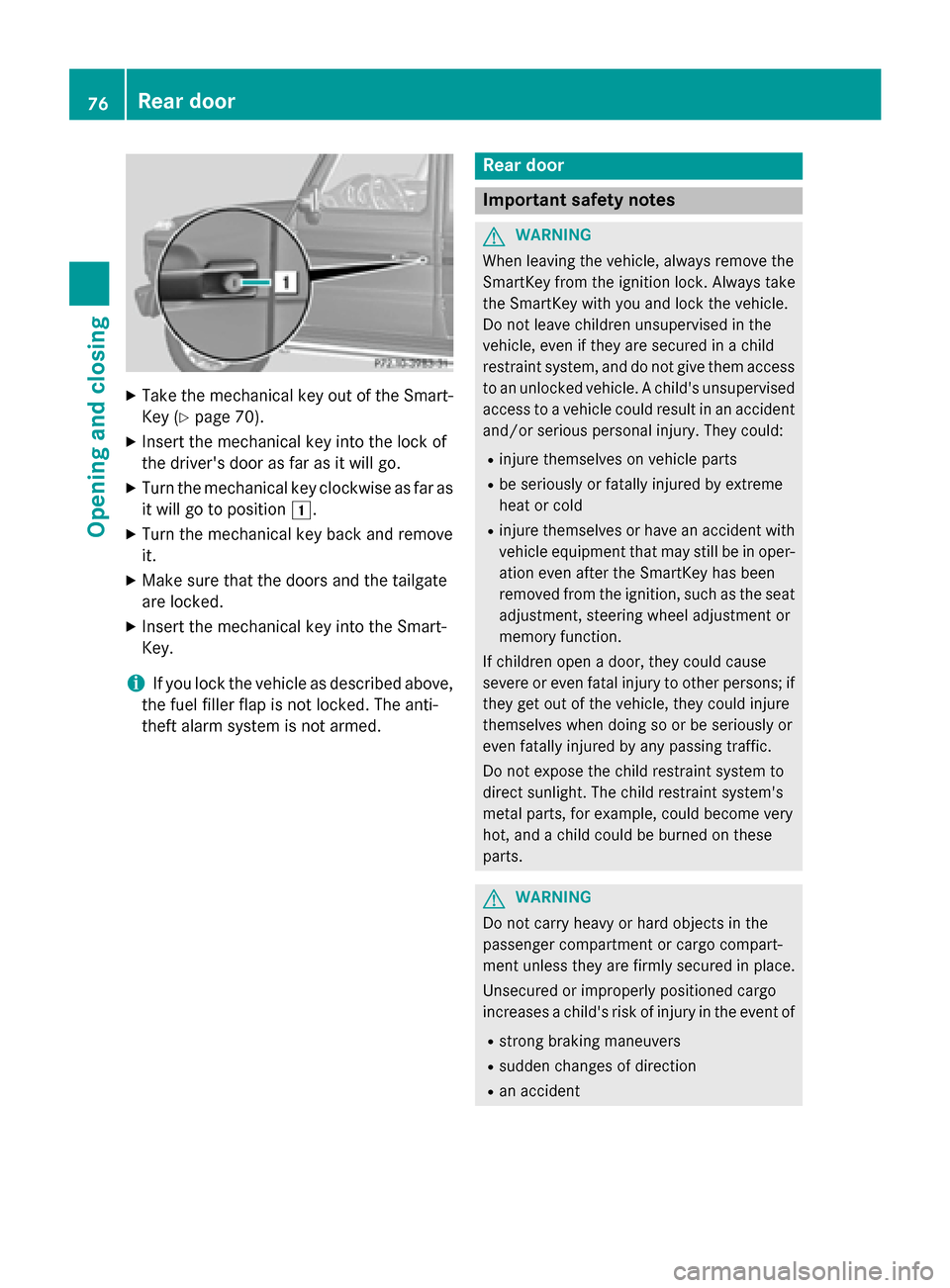
X
Take the mechanical key out of the Smart-
Key (Y page 70).
X Insert the mechanical key into the lock of
the driver's door as far as it will go.
X Turn the mechanical key clockwise as far as
it will go to position 1.
X Turn the mechanical key back and remove
it.
X Make sure that the doors and the tailgate
are locked.
X Insert the mechanical key into the Smart-
Key.
i If you lock the vehicle as described above,
the fuel filler flap is not locked. The anti-
theft alarm system is not armed. Rear door
Important safety notes
G
WARNING
When leaving the vehicle, always remove the
SmartKey from the ignition lock. Always take
the SmartKey with you and lock the vehicle.
Do not leave children unsupervised in the
vehicle, even if they are secured in a child
restraint system, and do not give them access to an unlocked vehicle. A child's unsupervised
access to a vehicle could result in an accident
and/or serious personal injury. They could:
R injure themselves on vehicle parts
R be seriously or fatally injured by extreme
heat or cold
R injure themselves or have an accident with
vehicle equipment that may still be in oper-
ation even after the SmartKey has been
removed from the ignition, such as the seat
adjustment, steering wheel adjustment or
memory function.
If children open a door, they could cause
severe or even fatal injury to other persons; if they get out of the vehicle, they could injure
themselves when doing so or be seriously or
even fatally injured by any passing traffic.
Do not expose the child restraint system to
direct sunlight. The child restraint system's
metal parts, for example, could become very
hot, and a child could be burned on these
parts. G
WARNING
Do not carry heavy or hard objects in the
passenger compartment or cargo compart-
ment unless they are firmly secured in place.
Unsecured or improperly positioned cargo
increases a child's risk of injury in the event of
R strong braking maneuvers
R sudden changes of direction
R an accident 76
Rear doorOpening and closing
Page 85 of 350
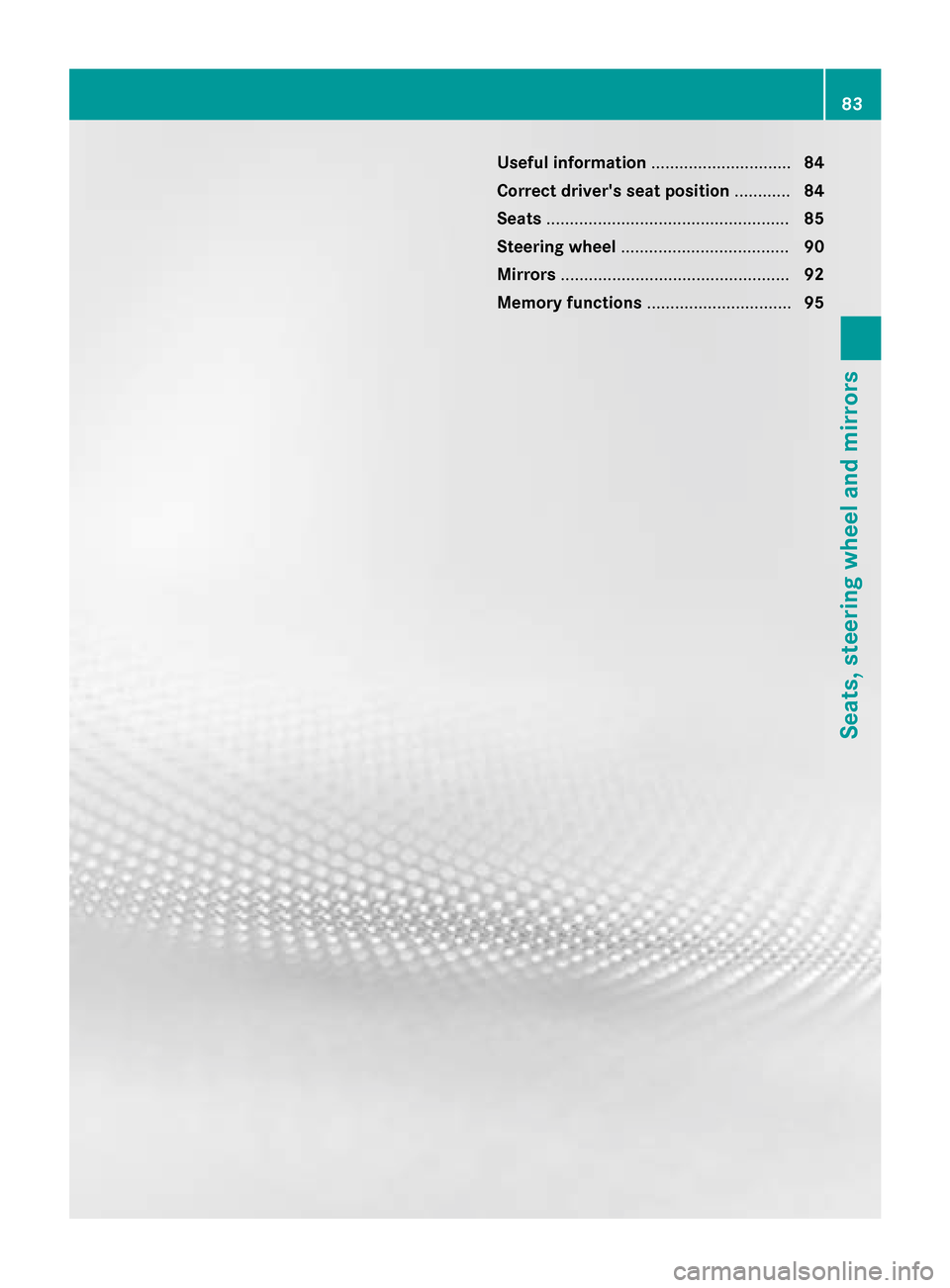
Useful information
..............................84
Correct driver's seat position ............84
Seats .................................................... 85
Steering wheel .................................... 90
Mirrors ................................................. 92
Memory functions ............................... 95 83Seats, steering wheel and mirrors
Page 86 of 350
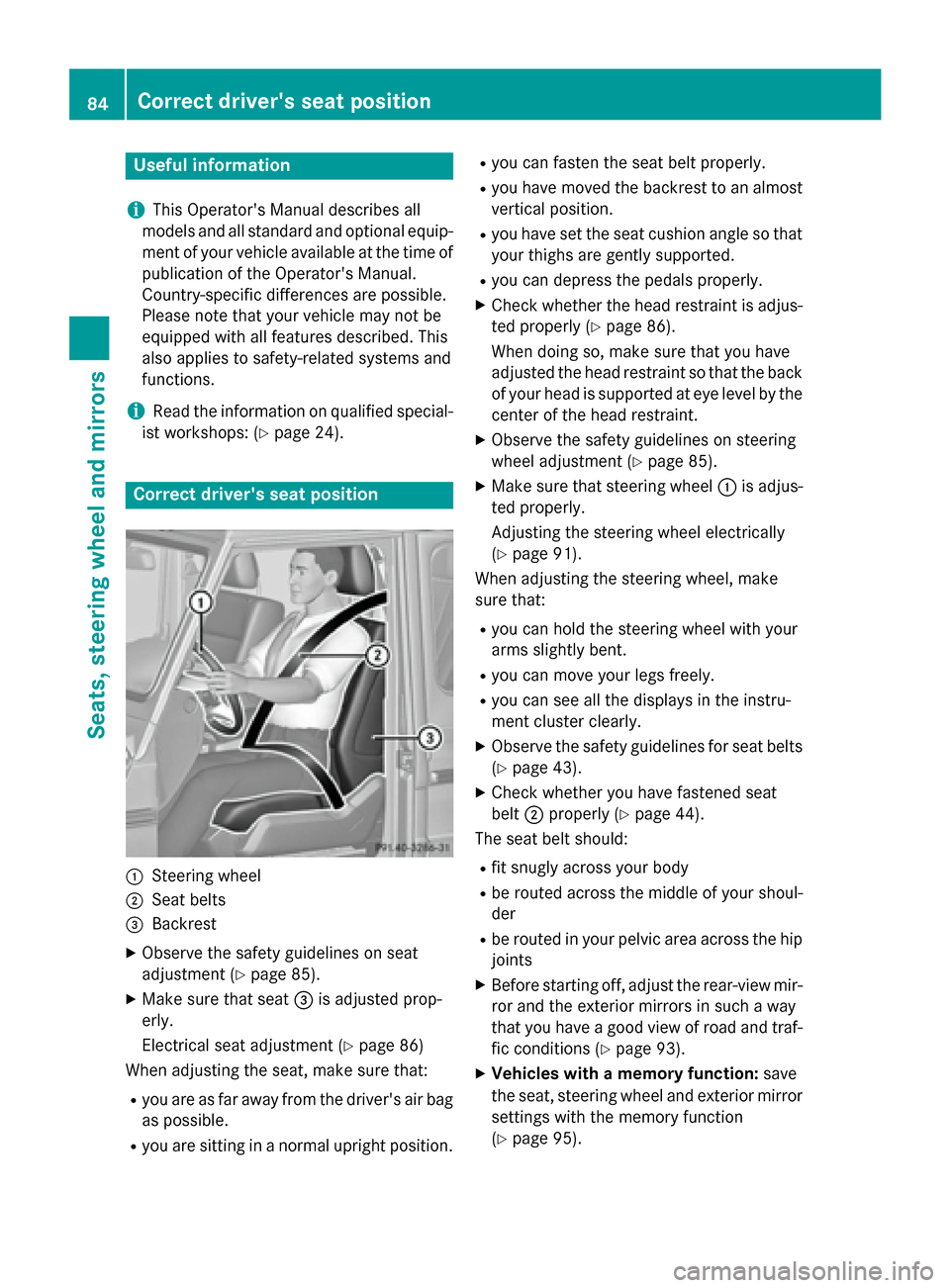
Useful information
i This Operator's Manual describes all
models and all standard and optional equip- ment of your vehicle available at the time of
publication of the Operator's Manual.
Country-specific differences are possible.
Please note that your vehicle may not be
equipped with all features described. This
also applies to safety-related systems and
functions.
i Read the information on qualified special-
ist workshops: (Y page 24). Correct driver's seat position
:
Steering wheel
; Seat belts
= Backrest
X Observe the safety guidelines on seat
adjustment (Y page 85).
X Make sure that seat =is adjusted prop-
erly.
Electrical seat adjustment (Y page 86)
When adjusting the seat, make sure that:
R you are as far away from the driver's air bag
as possible.
R you are sitting in a normal upright position. R
you can fasten the seat belt properly.
R you have moved the backrest to an almost
vertical position.
R you have set the seat cushion angle so that
your thighs are gently supported.
R you can depress the pedals properly.
X Check whether the head restraint is adjus-
ted properly (Y page 86).
When doing so, make sure that you have
adjusted the head restraint so that the back
of your head is supported at eye level by the center of the head restraint.
X Observe the safety guidelines on steering
wheel adjustment (Y page 85).
X Make sure that steering wheel :is adjus-
ted properly.
Adjusting the steering wheel electrically
(Y page 91).
When adjusting the steering wheel, make
sure that:
R you can hold the steering wheel with your
arms slightly bent.
R you can move your legs freely.
R you can see all the displays in the instru-
ment cluster clearly.
X Observe the safety guidelines for seat belts
(Y page 43).
X Check whether you have fastened seat
belt ;properly (Y page 44).
The seat belt should:
R fit snugly across your body
R be routed across the middle of your shoul-
der
R be routed in your pelvic area across the hip
joints
X Before starting off, adjust the rear-view mir-
ror and the exterior mirrors in such a way
that you have a good view of road and traf-
fic conditions (Y page 93).
X Vehicles with a memory function: save
the seat, steering wheel and exterior mirror
settings with the memory function
(Y page 95). 84
Correct driver's seat positionSeats, steering wheel and mirrors
Page 88 of 350
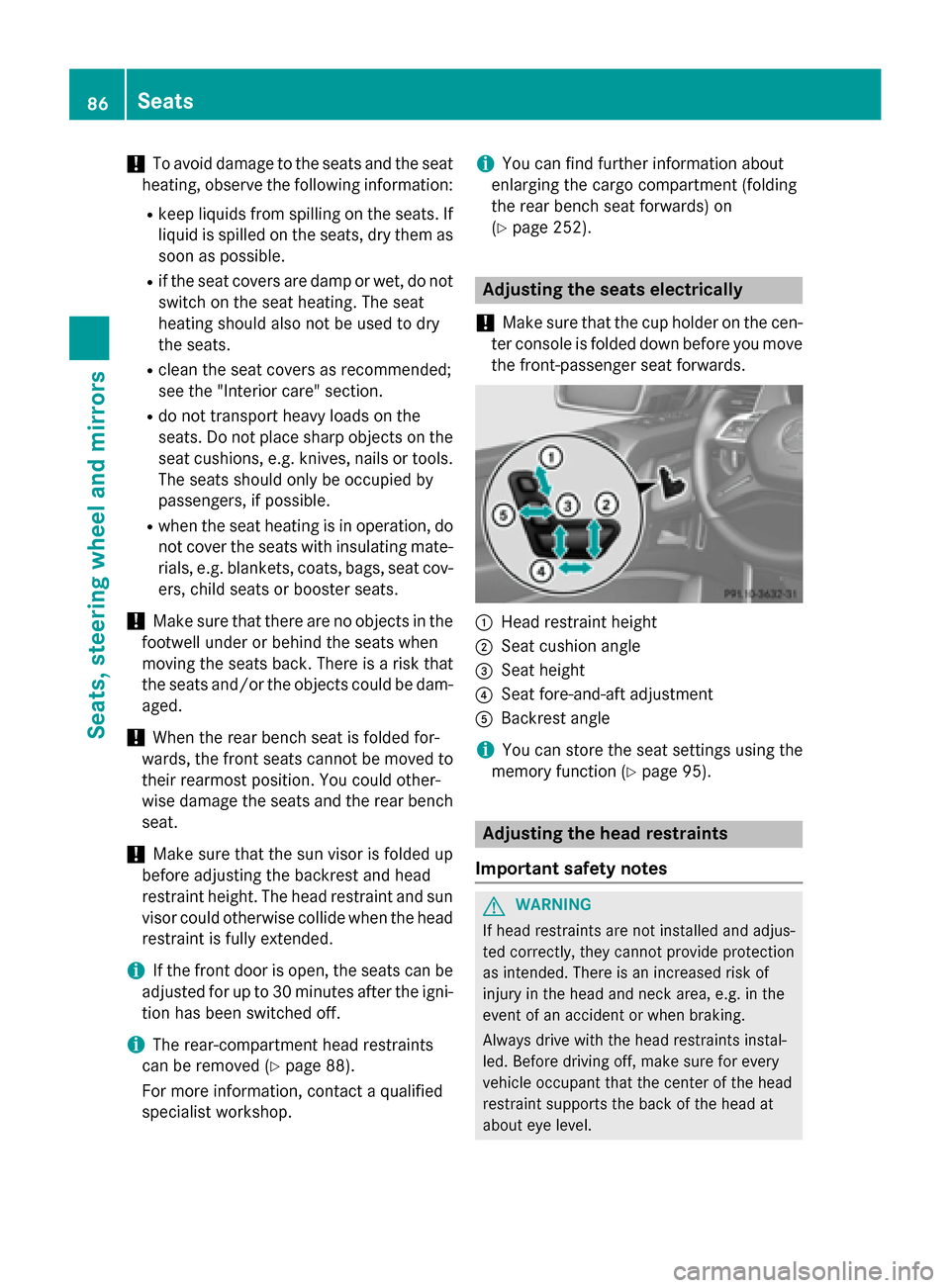
!
To avoid damage to the seats and the seat
heating, observe the following information:
R keep liquids from spilling on the seats. If
liquid is spilled on the seats, dry them as soon as possible.
R if the seat covers are damp or wet, do not
switch on the seat heating. The seat
heating should also not be used to dry
the seats.
R clean the seat covers as recommended;
see the "Interior care" section.
R do not transport heavy loads on the
seats. Do not place sharp objects on the seat cushions, e.g. knives, nails or tools. The seats should only be occupied by
passengers, if possible.
R when the seat heating is in operation, do
not cover the seats with insulating mate-
rials, e.g. blankets, coats, bags, seat cov- ers, child seats or booster seats.
! Make sure that there are no objects in the
footwell under or behind the seats when
moving the seats back. There is a risk that
the seats and/or the objects could be dam- aged.
! When the rear bench seat is folded for-
wards, the front seats cannot be moved to
their rearmost position. You could other-
wise damage the seats and the rear bench seat.
! Make sure that the sun visor is folded up
before adjusting the backrest and head
restraint height. The head restraint and sun
visor could otherwise collide when the head restraint is fully extended.
i If the front door is open, the seats can be
adjusted for up to 30 minutes after the igni- tion has been switched off.
i The rear-compartment head restraints
can be removed (Y page 88).
For more information, contact a qualified
specialist workshop. i
You can find further information about
enlarging the cargo compartment (folding
the rear bench seat forwards) on
(Y page 252). Adjusting the seats electrically
! Make sure that the cup holder on the cen-
ter console is folded down before you move
the front-passenger seat forwards. :
Head restraint height
; Seat cushion angle
= Seat height
? Seat fore-and-aft adjustment
A Backrest angle
i You can store the seat settings using the
memory function (Y page 95). Adjusting the head restraints
Important safety notes G
WARNING
If head restraints are not installed and adjus-
ted correctly, they cannot provide protection
as intended. There is an increased risk of
injury in the head and neck area, e.g. in the
event of an accident or when braking.
Always drive with the head restraints instal-
led. Before driving off, make sure for every
vehicle occupant that the center of the head
restraint supports the back of the head at
about eye level. 86
SeatsSeats, steering wheel and mirrors